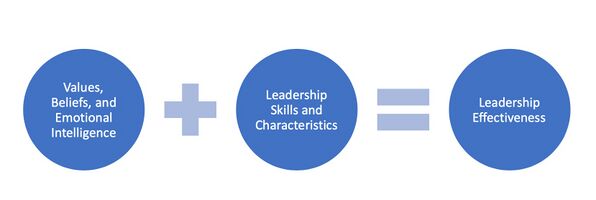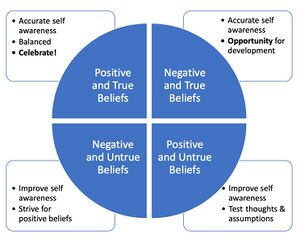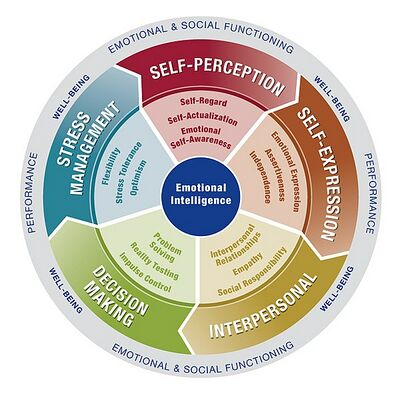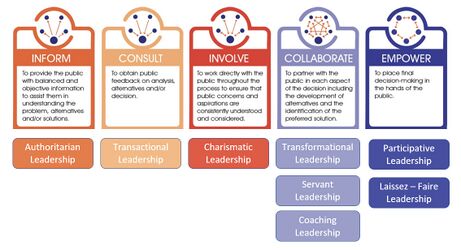Leading in Rehabilitation - Implement the Leadership Approach: Difference between revisions
No edit summary |
No edit summary |
||
| Line 240: | Line 240: | ||
* Ask curious questions to expose ideas, promote creativity, and uncover assumptions | * Ask curious questions to expose ideas, promote creativity, and uncover assumptions | ||
|- | |- | ||
|Coaching | |Coaching<ref>Rapp-Ricciardi M, Garcia D, Archer T. [https://www.researchgate.net/profile/Max-Rapp-Ricciardi-2/publication/317137055_Personal_Attributes_Linked_to_Empowerment_that_Influence_Receptivity_to_Coaching_Leadership/links/6058b4d0299bf17367606f84/Personal-Attributes-Linked-to-Empowerment-that-Influence-Receptivity-to-Coaching-Leadership.pdf Personal attributes linked to empowerment that influence receptivity to coaching leadership]. Coaching: An International Journal of Theory, Research and Practice. 2018;11(1):30-45.</ref> | ||
| | | | ||
* Inquires | * Inquires | ||
Revision as of 04:31, 17 April 2022
Original Editor - Jess Bell based on the course by
Jason Giesbrecht
Top Contributors - Jess Bell and Kim Jackson
Introduction[edit | edit source]
There is often a gap between knowing about leadership and actually doing the leading. Bridging this gap can help people in informal and formal leadership roles become capable and influential leaders in rehabilitation. Leaders must be able to:
- Assess the situation
- Select an appropriate leadership approach
- Implement the leadership approach
- Reflect on and learn from the experience
This page focuses on the third step of implementing the optimal leadership approach. It explores specifically eight prominent leaderphip styles, which are discussed in detail here. These leadership styles are:
- Transformational
- Transactional
- Charismatic
- Servant
- Laissez-faire (delegative)
- Authoritarian (autocratic)
- Participative (democratic)
- Coaching
Leadership Effectiveness[edit | edit source]
Essentially, leaders strive to achieve leadership effectiveness (see Figure 1), which is defined as:
“The successful exercise of personal influence by one or more people that results in accomplishing shared objectives in a way that is personally satisfying to those involved.”[1]
The personal influence described in this quote refers to the combined impact of personal values, beliefs, and emotional intelligence. Together, these provide a foundation for the implementation or execution of a leadership approach.[2]
Values, beliefs, and emotional intelligence provide a basis upon which the leadership approach, or the leadership skills and characteristics associated with each approach, can be implemented.[2]
Personal Values[edit | edit source]
"[P]ersonal values can be defined as trans-situational goals that vary in importance and serve as guiding principles in people’s lives."[3]
They are the inner standards from which you receive the motivation to act and by which you make decisions and judge behaviour. They represent a deep expression of what is most important to you.[2]
Beliefs[edit | edit source]
Beliefs are thoughts, assumptions, outlooks and attitudes that we favour about ourselves and others (Figure 2). They arise from evidence, tradition, authority, association, and revelation.[2]
Belief domains are summarised in Table 1.
| Domains | Positive Beliefs | Negative Beliefs |
|---|---|---|
| Self | “I am worthy of love and happiness” | “I am flawed and unlovable” |
| Others | “Others like me and value my opinion” | “People are generally hurtful and disloyal” |
| The world | “The world is my oyster!” | “The world is a dangerous place” |
| The future | “The future is bright and opportunity awaits” | “There is no hope – things will never get better” |
What is Emotional Intelligence?[edit | edit source]
"Emotional intelligence (EI) can be defined as the ability to identify, express, understand, manage, and use emotions. EI has been shown to have an important impact on health, relationships, and work/academic performance."[4]
It enables individuals to:[2]
- Recognise, understand, and manage the emotions of one's self, and of others
- Express our thoughts
- Develop and maintain social relationships
- Cope with challenges
- Use emotional information in an effective and meaningful way
Emotional quotient is a measure of emotional intelligence.[5] [6] It incorporates: self-awareness; self-management; social awareness; and relationship management.[6]
Bar-On Model of Emotional Intelligence[edit | edit source]
In order to understand emotional intelligence, it can be helpful to use the Bar-On model of emotional and social intelligence (see Figure 3). This model consists of five main sections known as composites:
- Self-perception
- Self-expression
- Interpersonal
- Decision making
- Stress management
Each composite has three subscales. More information on this model is available here and in the Physioplus course: Emotional Intelligence.
Implement the Leadership Approach[edit | edit source]
After assessing the situation and selecting an appropriate leadership style, it is necessary to implement the chosen leadership approach. The following table, adapted from Jason Giesbrecht[2] provides a summary of the key characteristics of eight common leadership approaches, ideas for self-assessment and tips when implementing these leadership styles.
| Leadership Approach | Characteristics | Self-Assessment | Implementation Tips |
|---|---|---|---|
| Transformational[7] |
|
|
|
| Transactional[8] |
|
|
|
| Charismatic[9] |
|
|
|
| Servant[10] |
|
|
|
| Laissez-faire/ delegative[11] |
|
|
|
| Authoritarian / autocratic[12] |
|
|
|
| Participative / democratic[13] |
|
|
|
| Coaching[14] |
|
|
|
The International Association of Public Participation[15] has developed a powerful tool that demonstrates the fundamental five levels of engagement. As is shown in Figure 4, it starts on the left side with "inform" and moves to the right to "empowerment". It is important to consider which level of engagement needs to be applied in a specific situation.
There are risks that a team / audience may believe the leader is at one level of engagement (e.g. collaboration) but the leader believes that they are at another level of engagement (e.g. inform). By keeping these discrepancies in mind while planning engagement sessions will help keep the leader safe.
Leadership Approach Preferences[edit | edit source]
- Some leadership approaches come easily…others, require more work
- What is your “natural” or preferred leadership approach?
- Become aware of your natural tendency…and manage the impulse to use this style in all situations.
- Develop your ‘out of preference’ leadership styles[2]
References[edit | edit source]
- ↑ Cooper JF, Nirenberg J. Leadership effectiveness. In Encyclopedia of Leadership. Ed. Thousand Oaks, CA: SAGE, 2004. p845-54.
- ↑ 2.0 2.1 2.2 2.3 2.4 2.5 2.6 2.7 Giesbrecht J. Implement the Leadership Approach Course. Physioplus. 2022.
- ↑ Barni D, Danioni F, Benevene P. Teachers' self-efficacy: the role of personal values and motivations for teaching. Front Psychol. 2019;10:1645.
- ↑ Kotsou I, Mikolajczak M, Heeren A, Grégoire J, Leys C. Improving emotional intelligence: a systematic review of existing work and future challenges. Emotion Review. 2019;11(2):151-65.
- ↑ Gilar-Corbi R, Pozo-Rico T, Sánchez B, Castejón JL. Can emotional intelligence be improved? A randomized experimental study of a business-oriented EI training program for senior managers. PLoS One. 2019 23;14(10):e0224254.
- ↑ 6.0 6.1 Sánchez-Teruel D, Robles-Bello MA, Camacho-Conde JA. Assessment of emotional intelligence in adults with down syndrome: Psychometric properties of the Emotional Quotient Inventory. PLoS One. 2020;15(7):e0236087.
- ↑ Baskarada S, Watson JC, Cromarty J. Balancing transactional and transformational leadership. International Journal of Organizational Analysis. 2017;25: 506-15.
- ↑ Nielsen PA, Boye S, Holten A-L, Jacobsen CB, Andersen LB. Are transformational and transactional types of leadership compatible? A two-wave study of employee motivation. Public Admin. 2019;97:413-28.
- ↑ Banks GC, Engemann KN, Williams CE, Gooty J, Davis McCauley K, Medaugh MR. A meta-analytic review and future research agenda of charismatic leadership. The Leadership Quarterly. 2017;28(4):508-29.
- ↑ Eva N, Robin M, Sendjaya S, van Dierendonck D, Liden RC. Servant leadership: a systematic review and call for future research. The Leadership Quarterly. 2019;30(1):111-32.
- ↑ Chapter Seven: BEING A LEADER. In: Therapeutic Recreation (5th ed) [Internet]. Sagamore Publishing; 2004 [cited 2022 Apr 4]. p. 323–61. Available from: https://search.ebscohost.com/login.aspx?direct=true&db=rss&AN=20094194&site=ehost-live
- ↑ Wang H, Guan B. The positive effect of authoritarian leadership on employee performance: the moderating role of power distance. Front Psychol. 2018;9:357.
- ↑ Odoardi C, Battistelli A, Montani F, Peiró JM. Affective commitment, participative leadership, and employee innovation: a multilevel investigation. Journal of Work and Organizational Psychology. 2019;35:103-13.
- ↑ Rapp-Ricciardi M, Garcia D, Archer T. Personal attributes linked to empowerment that influence receptivity to coaching leadership. Coaching: An International Journal of Theory, Research and Practice. 2018;11(1):30-45.
- ↑ International Association for Public Participation. IAP2 Spectrum of Public Participation. Available from: www.iap2.org (accessed 17 April 2022).










